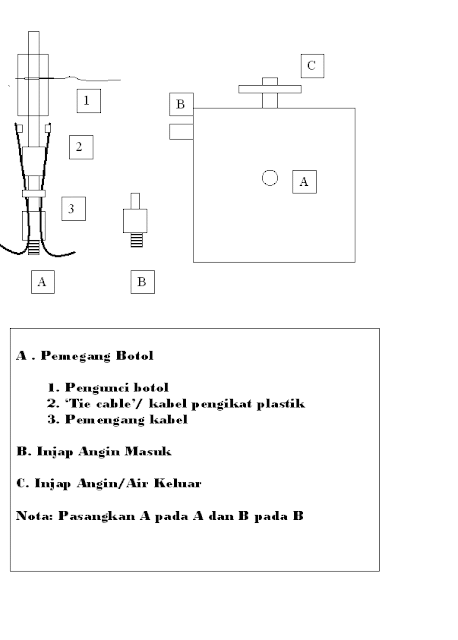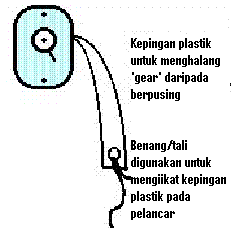Masalah yang selalu dihadapi oleh peserta2 pertandingan roket payung terjun ialah payung terjun gagal keluar dari muncung dan kembang di udara Projek yang sedang saya usahakan sekarang adalah merupakan salah satu cara untuk mengatasi masalah ini, iaitu dengan menggunakan satu alat yang dinamakan jangka spring untuk mengeluarkan payung dari muncung roket h2o. Idea projek ini diperolehi daripada pembacaan dari laman web.
Jangka spring (seperti gambar di atas) boleh didapati daripada permainan kanak2. Ada banyak jenis jangka spring dan yang terbaik ialah pilihan yang paling kecil dan ringan untuk mengurangkan berat roket h2o anda nanti.
Langkah seterusnya ialah keluarkan jangka spring dari mainan tersebut dan buatkan satu lubang yang kecil pada bahagian tombolnya. Masukkan besi klip kertas yang dipotong pendek ke dalam lubang tersebut seperti gambar di atas. Gamkan besi klip kertas tersebut dengan gam gajah (501) supaya tidak tertanggal dari lubang yang dimasukkan tadi.
Potong sekeping plastik tebal // plastik dari botol untuk dijadikan suis semasa pelancaran nanti. Plastik ini akan di masukkan bahagian hujungnya ke dalam jangka spring supaya ‘gear’ nya tidak dapat berpusing sebelum pelancaran dilakukan. Bahagian hujung yang satu lagi akan diikat pada pelancar. Plastik ini akan ditarik keluar dari ‘gear’ semasa pelancaran dan jangka spring ini akan berfungsi sepenuhnya apabila roket h2o meninggalkan pelancar. (lihat gambarajah di atas)
Bagaimana menggunakan jangka spring
Muncung roket h2o akan di ikat dengan 2 getah. Satu getah akan disambungkan dengan jangka spring dan satu lagi (yang lebih panjang) akan digunakan untuk menarik muncung tertanggal dari badan roket h2o.
Langkah pertama yang perlu dilakukan ialah menebuk 2 lubang bertentangan lebih kurang 3 cm dari hujung bawah pada muncung roket h2o. Ambil klip kertas dan bentukkannya menjadi huruf T. Masukan klip kertas tadi ke dalam lubang yang telah ditebuk dan tampalkan bahagian dalamnya dengan menggunakan ‘binding tape’.
Langkah kedua, ikatkan getah yang panjang pada bahagian bawah roket h2o// bhg ‘nozzle’. Letakkkan muncung pada badan roket h2o. Ikatkan getah panjang ini pada klip kertas pada muncung. Uji samada getah panjang ini boleh menarik muncung terpisah daripada badan roket h2o. Jika tidak dapat, pendekkan sedikit getah tersebut. Uji semula.

Langkah ketiga, lekatkan jangka spring pada salah satu sayap roket anda (Sayap yang anda bina mestilah kuat dan dilekatkan dengan kemas). Lekatkan muncung pada badan rorket h2o anda, Ikatkan satu benang pada getah yang sederhana panjang. Buat satu bulatan pada hujung benang untuk dimasukkan nanti pada besi klip kertas yang dilekatkan pada tombol. Kemudian Ikatkan getah tersebut pada satu lagi klip kertas yang bertentangan pada bahagian muncung. Tarik getah ini sehingga sampai kepada jangka spring. Laraskan masa yang diambil untuk memisahkan muncung dari badan roket h2o dengan cara melaraskan ketegangan getah yang disambung pada jangka spring iaitu dengan cara mengubah panjang benang.
Selamat mencuba…..cg akan uploadkan gambar2 yang berkaitan dengan jangka spring ini sedikit masa lagi…jangan lupa untuk selalu melawat laman blog ini.
.























